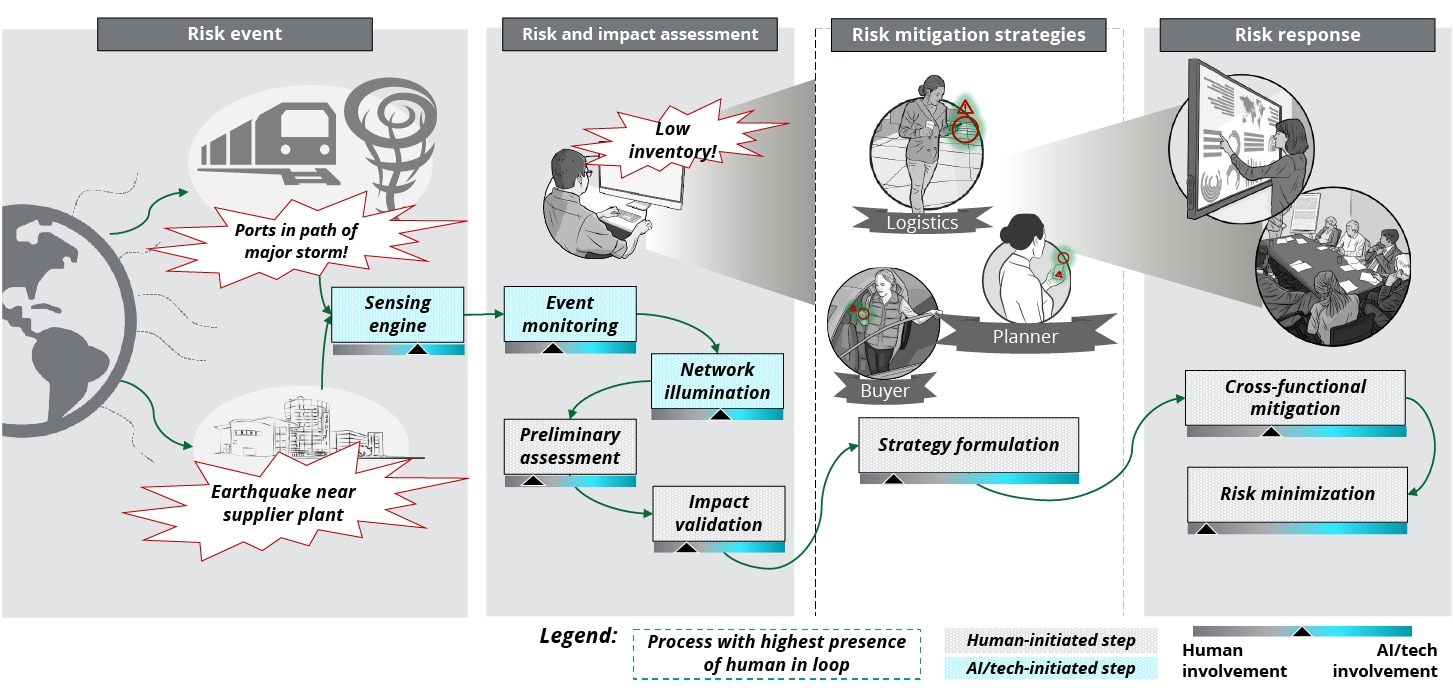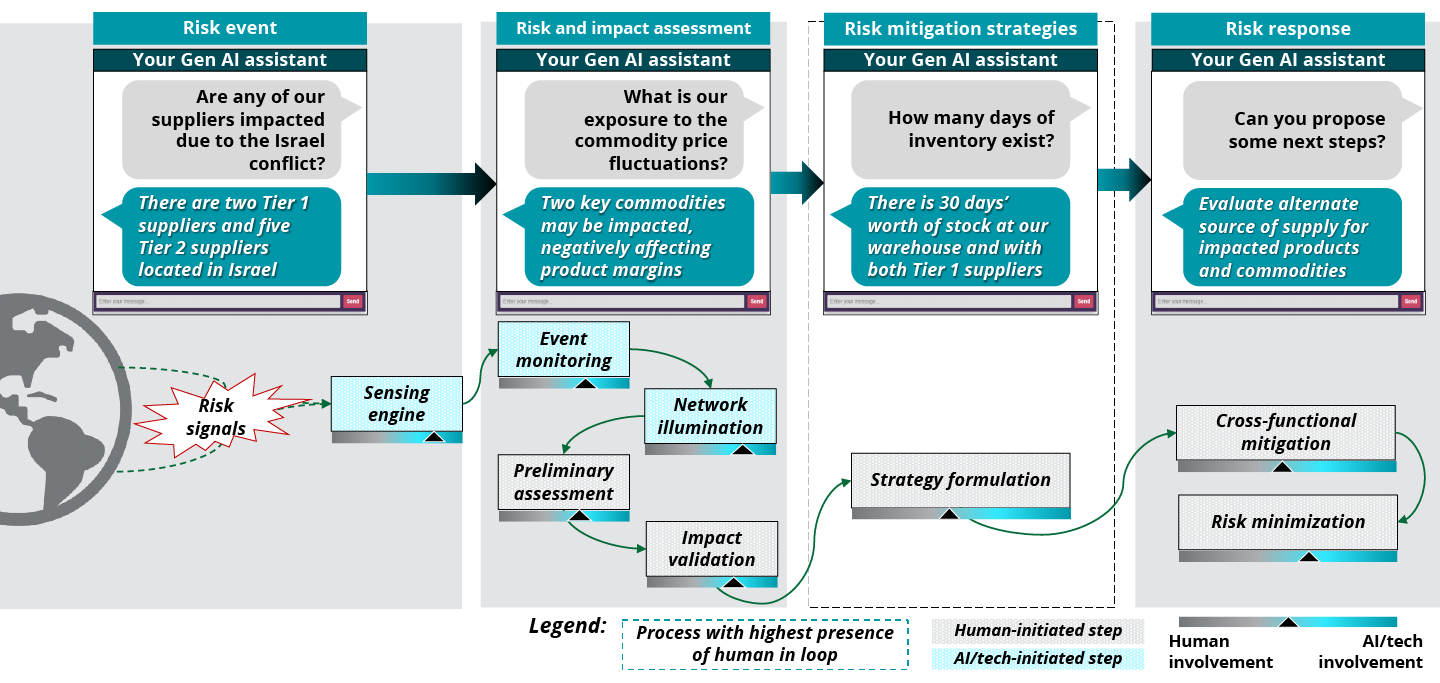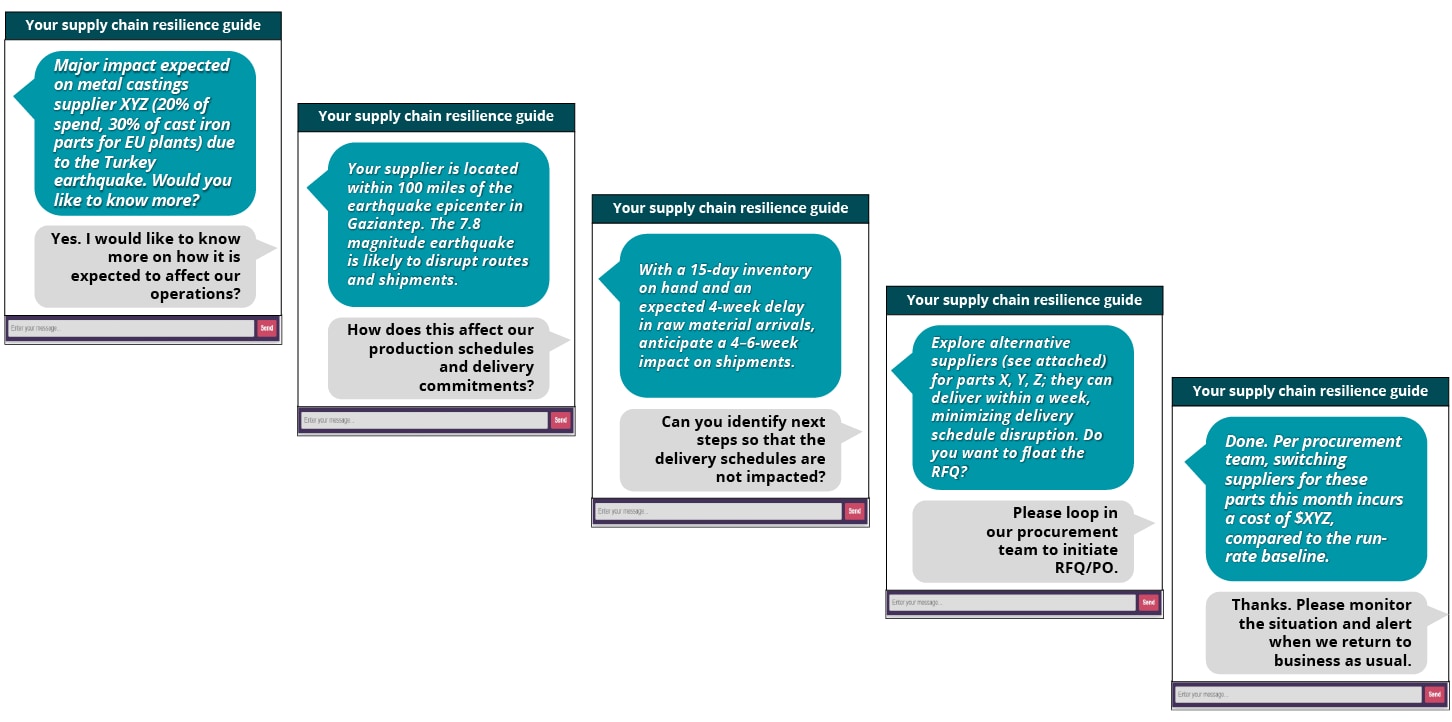Generative AI-Powered Supply Chain Resilience | Deloitte US has been saved
Evolution of supply chain resilience
Driven by technological advancements such as big data, the internet of things, analytics, and, more recently, generative artificial intelligence (or Gen AI), supply chain resilience (SCR) has evolved from being predominantly a set of simple reactive levers in order to respond to risks into a more proactive, agile, adaptable, and efficiently guided methodology to respond to potential disruptions. New-age technologies including generative AI have a potential to positively impact aspects of supply chain resilience, from identifying priorities of an organization’s supply chain strategy to proactively responding to risk events, to effectively drive risk mitigation through early/proactive identification of risks and continuous monitoring improvements in risk profiles in complex multitier supply chain networks.
The evolution of supply chain resilience builds upon smart factory elements, such as the supplier quality management system, which entails creation of automated workflows (such as supplier performance, monitoring, and quality risk assessment), real-time data exchange, and, more importantly, predictive analytics of supplier risks—to enable data-driven insights and action.
The future of supply chain resilience entails proactive, prescriptive, and guided risk mitigation, which involves increasing flexibility, adaptability, and turnaround time to respond to risk events, such as cataclysmic events (earthquakes, cyclones, pandemic, etc.), risks arising due to geopolitical instabilities, changing regulatory environments, logistical disruptions, or supplier-specific risk events. By leveraging generative AI in the supply chain for real-time risk response assessment and artifact creation, supplier–buyer collaboration can be streamlined, leading to proactive and efficient risk response and mitigation, with “rightsized” human-in-the-loop focus on value-added activities. The business impacts can be particularly profound for time-sensitive risk events.
Supply chain resilience today is still driven by manual interventions/human-in-the-loop
As disruptions become more frequent, businesses have started to incorporate risk management processes and techniques into their larger supply chain strategy. In the current state, there is a significant human-in-the-loop involvement, as a lot of time is spent on activities such as data gathering, cleaning, and preparation rather than real analysis, insight generation, and response activation. There is very limited usage of enterprise data and technology, let alone artificial AI/machine learning. Key activities for risk detection and response are typically initiated by (and thus are dependent on) the human in the loop. While humans are undoubtedly critical to the success of supply chain resilience priorities, in the current state, a significant volume of tactical tasks inflate the number of full-time employee hours required to analyze and respond to a typical risk event. Most solutions available in the market today lack the ability to provide prescriptive insights and actionable recommendations, resulting in dedicated teams and manual processes.
Supply Chain Resilience: The Current State
Click image to enlarge
Image: SCR current state with limited technology/AI intervention and more dependence on human in the loop to execute tactical and non-value-added tasks
Generative AI can boost the efficiency of the current risk response process by acting initially as an assistant and eventually as a guide
Generative AI models can be leveraged to scan global events to proactively identify potential risks. They can also automatically produce risk assessment reports, conduct scenario simulations, and develop proactive operational/strategic risk mitigation strategies. This can help an organization’s supply chain functions to effectively manage and mitigate risks. Generative AI’s conversational interface can make the risk mitigation process much more user-friendly with increased speed to response. This can eventually culminate into a system-guided, data-facilitated approach to respond to risk events that builds upon a comprehensive library of scenarios and risk mitigation levers, resulting in contextualized response to risk events.
Supply Chain Resilience: The Future State powered by Gen-AI
Click image to enlarge
Image: GenAI-powered SCR: The SCR assistant
Supply network illumination capabilities:
- Enable better visibility of multitier supply chain networks.
- Help proactively identify insights from network data faster through advanced data extraction and visualization for quicker and more accurate identification of buy-sell relationships.
Risk event identification capabilities:
- Enhance coverage and output of risk-sensing engines by bringing intelligent risk-sensing models that provide real-time insights and enhance decision-making.
- Combine internal and external risk indicators to predict performance of suppliers that are trending badly/worse and prompt users proactively.
- Track changes in global regulations to proactively deduce impact on specific industries and organizations.
- Conversationally help identify potential nodes of failure based on key considerations such as geopolitical events, propensity of natural disaster, category trends, demand variability, regulatory factors, supplier location, supplier past performance, etc.
Risk impact assessment capabilities:
- Act as the “first stop” for assessing impact of events on global supply chains.
- Help provide a preliminary analysis of categories, commodities, suppliers, customers, production locations, etc. affected by disruption and automate prioritization of risks, resulting in creation of dynamic risk and impact assessment reports.
Risk mitigation capabilities:
- Generate customized content and artifacts such as risk reports, mitigation plans, communication templates, etc. based on the organization’s priorities and processes to operationalize risk mitigation strategies.
- Drive interactive and conversational cross-functional risk mitigation and scenario-enabled planning and execution.
- Scan the current inventory levels, production schedules, alternate designs, and alternate sources of procurement in events of disruptions to propose viable next steps to mitigate the impact of risk events on the downstream supply chain.
- Help organizations develop a “step-by-step” risk mitigation approach as more information around risk events is received, based on a repository of levers and strategies that can be queried to identify next steps.
- Auto-populate compliance documents and requests when materials are seized for regulatory issues.
Risk response capabilities:
- Risk scenarios can be configured as a library within generative AI, which would use those to provide future recommendations for a similar type of issue when certain conditions or thresholds are met. For example, in the event of a supply chain disruption, generative AI can automatically activate the most favorable contingency plans, reroute shipments, or reorder inventory with limited to zero manual intervention, reducing response time and ensuring a swift reaction.
- Facilitate intelligent collaboration among supply chain stakeholders by identifying critical communication points, analyzing interactions, and ensuring timely responses.
Below is an example of how generative AI can enable a guided response to a disruptive event in the supply chain:
Supply Chain Resilience: Gen-AI guided Prescriptive Risk Response
Click image to enlarge
Image: A day in the life of an analyst with guided SCR through GenAI—the SCR Guide
Conclusion
Advancements in generative AI can help make identifying and mitigating risks more proactive, prescriptive, and efficient versus the traditional approaches and can result in significant savings in time, resources, and cost spent in risk management activities. Particularly in the context of time-sensitive risks, the minimization of disruptions in inbound supply can have significant cascading effects in the downstream day-to-day operations. By and large, the evolving paradigm will bring its challenges of adoption and change, but as supply chains continue to become more complex and risk events more frequent and varied, technology, AI, and generative AI-driven supply chain resilience will have significant roles to play.
Authors:
Aaron Parrott | Vijay Natarajan |
Thank you to our contributors: Kreeti M., Supragya S., Prasanna V.




